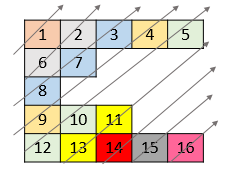973. K Closest Points to Origin
We have a list of points on the plane. Find the K closest points to the origin (0, 0).
(Here, the distance between two points on a plane is the Euclidean distance.)
You may return the answer in any order. The answer is guaranteed to be unique (except for the order that it is in.)
Example 1:
Input: points = [[1,3],[-2,2]], K = 1 Output: [[-2,2]] Explanation: The distance between (1, 3) and the origin is sqrt(10). The distance between (-2, 2) and the origin is sqrt(8). Since sqrt(8) < sqrt(10), (-2, 2) is closer to the origin. We only want the closest K = 1 points from the origin, so the answer is just [[-2,2]].
Example 2:
Input: points = [[3,3],[5,-1],[-2,4]], K = 2 Output: [[3,3],[-2,4]] (The answer [[-2,4],[3,3]] would also be accepted.)
Note:
1 <= K <= points.length <= 10000-10000 < points[i][0] < 10000-10000 < points[i][1] < 10000
给定二维平面上的若干个点,求距离原点最近的K个点。
事实上,诸如此类的,要在一个数组中寻找第K大的数(或者第K小的数),前K大的数,前K小的数,一般来说的方法有:
1.先排序(快排)时间复杂度为nlogn
2.建堆,堆的大小为K,建立大根堆或者小根堆,时间复杂度为nlogK(如果要求出前K个较大的,那么就建立小根堆,一旦比堆顶大,那么就入堆);
3.结合快速排序划分的方法,不断减小问题的规模
对于这一题,采用解法3,即快排划分的思路。采用标准快排思路,每次选区间最右边的元素作为pivot,然后划分,看看划分后的pivot位置和K的大小关系,递归在左右区间进行划分。完整代码如下:
class Solution {
private:
vector<int> origin;
int CalDist(vector<int> &p1, vector<int> &p2) {
return (p1[0] - p2[0]) * (p1[0] - p2[0]) + (p1[1] - p2[1]) * (p1[1] - p2[1]);
}
void MySwap(vector<vector<int>>& points, int u, int v) {
swap(points[u][0], points[v][0]);
swap(points[u][1], points[v][1]);
}
void Work(vector<vector<int>>& points, int l, int r, int K) {
if (l >= r) return;
int pivot = r;
int pdist = CalDist(points[pivot], origin);
int i = l;
for (int j = l; j < r; ++j) {
int idist = CalDist(points[j], origin);
if (idist < pdist) {
MySwap(points, i++, j);
}
}
MySwap(points, i, pivot);
if (K == i)return;
else if (K < i)Work(points, l, i - 1, K);
else Work(points, i + 1, r, K);
}
public:
vector<vector<int>> kClosest(vector<vector<int>>& points, int K) {
origin = { 0, 0 }; // 求与该点距离最近的top-k个点,本题中该点是原点
for (int i = 0; i < points.size(); ++i) {
printf("x=%d,y=%d,dist=%d\n", points[i][0], points[i][1], CalDist(points[i], origin));
}
Work(points, 0, points.size() - 1, K - 1);
vector<vector<int>> ans;
for (int i = 0; i < K; ++i) ans.push_back(points[i]);
return ans;
}
};本代码提交AC,用时612MS。

